Note: If an image ever fails to appear - refresh your page, it really is there
The Evolution of the Polish Coat-of-Arms - Part 1
by Chrystian Kretowicz and Peter Loeser
| Polish Coat-of-Arms Part 1 | Polish Coat-of-Arms Part 2 |
The crowned White Eagle has been the coat-of-arms of the Polish State for seven centuries. It is one of the oldest State coats-of-arms in the world. There are very few other countries who have managed to maintain their coats-of-arms for such a long period of time.
 |
|
Several historic traditions and legends have referred to the origins of the White Eagle, the most popular moving it back to the times when the Polish State was being first established. This popular legend says the chieftain of the tribe of Polans (Polanie), Lech, sighted a white eagle flying off a nest and backed by a spectacular sundown. It inspired Lech to choose this royal bird as both his families royal symbol and also as a symbol for the Polish state. Thus, the White Eagle became the national sign of the proud nation of the Poles and would continue to evolve over the next thousand years. The legend of Lech's discovery of the eagle's nest (in Polish: "gniazdo"), also gave name to Poland's first capital, Gniezno. |
|
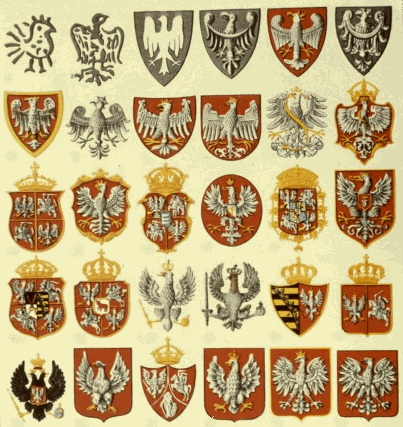 |
Jan Dlugosz, Poland's most distinguished chronicler living in the 15th Century, wrote a different version of the White Eagle's origin. He related that Duke Boleslaw Chrobry was granted the Eagle as his coat-of-arms by Emperor Otto III during a meeting of both monarchs in Griezno in the year 1000. In reality, the real origin of the White Eagle is probably not so distant in the past, because, generally, coats-of-arms did not exist before the 12th Century.
Actually, Mieszko I (962-992), the first historical ruler of Poland, who brought his nation into the fold of Christianity and was rewarded by the Pope with the title "Princeps Poloniae," (Great or High Duke) used the cross as his symbol on a coin minted under his authority, instead of the White Eagle.
|
|
|
|
|
Coin of Mieszko the First
962 |
|
Coin of Boleslaus the Brave
1000 |
|
Seal of Casimir the Just
1177 |
Boleslaus the Brave (992-1025), the Son of Mieszko the First, was crowned as the first King of Poland in 1025, and had a coin minted around the year 1000 with a bird resembling the eagle (or the peacock, dove, or chicken as some suspect). It would be the first representation of the Polish national symbol. The first documented example of the use of the eagle is on the seal of the High Duke of Cracow, Casimir the Just (1173-1194).
The eagle on the coat-of-arms and on the seals of the rulers of the Piast Dynasty between the years 1222-1236 was common. It was their personal and family coat-of-arms and at the same time the emblem of their dukedoms. The eagles was selected as their coat-of-arms for its symbolic values. As the king of all birds it was a primeval symbol of power, victory, force and kingship.
The Evolution of the White Eagle Chart - Part 1
Coat-of-Arms |
Some descriptive Text from
Wikipedia, the Free Encyclopedia. |
Supportive Artifact |
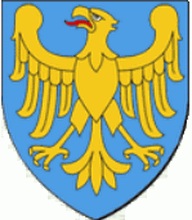 (1211-1230) Upper Silesia |
Coat-of Arms of Kazimierz (Casimir) I Opolski
The first eagles appearing on the shields of the early Silesian princes were uncrowned. Here is an example of the one from the seal of Prince Kazimierz (Casimir) I Opolski, ruler of the Principality of Opole-Raciborz in Upper Silesia (1211-1230).
The golden eagle on the blue shield is just a speculation as these colors are associated with the Upper Silesia region. This speculation is justified by the fact it was a personal symbol of the Prince in his capacity of being a ruler of his own realm the Principality of Opole-Raciborz. |
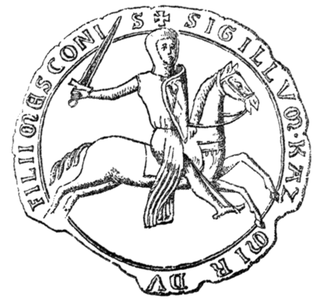 Seal of Casimir I Opolski |
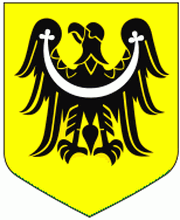 (1288-1290) Lower Silesia |
Coat-of-Arms of Henryk IV Probus
Here is an example of the eagle of Lower Silesia. Henryk IV Probus, also High Duke of Poland, used the traditional black eagle on the gold shield with the characteristic band in the shape of the crescent moon across its chest and wings.
There is no preserved evidence of the eagles used as synbols of the senior dukes in Cracow during the period of the feudal disintegration of Poland.
|
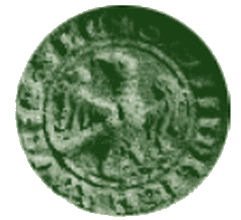 Seal of Henryk IV Probus |
 (1241-1243) |
Coat-of-Arms of High Duke Konrad Mazowieki
Konrad Mazowieki was the Duke of Mazovia and Czersk, and High Duke of Poland (1241-1243) during the period of feudal disintegation. He used the white uncrowned eagle on the red shield as his symbol in contrast to the different colors used by the Silesian Piast princes and dukes (gold on blue in Upper Silesia and black on gold in Lower Silesia).
Konrad is remembered for inviting the Teutonic Knights to help him subdue the pagan Prussians in the north-east of his domain.
|
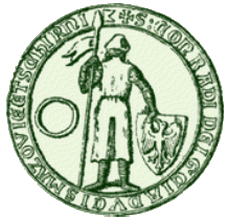 Seal of Konrad Mazowieki |
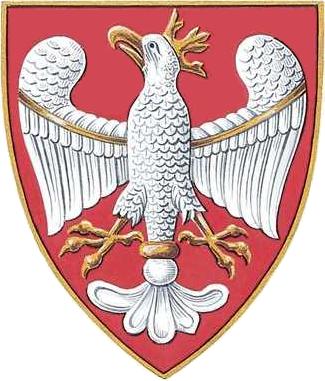 (1295-1296) |
Coat-of-Arms of King Przemysl (Premyslas) II
Przemyslaw II (also given in English and Latin as Premyslas or Premislaus) (14 October 1257 – 8 February 1296) was the Duke of Poznan, Greater Poland, Kraków and Pomerelia, and then King of Poland from 1295 until he was assassinated the next year in 1296.
After a long period of Polish High Dukes, and two nominal kings, he was the first one into obtain the hereditary title of King, and for Poland the rank of Kingdom. |
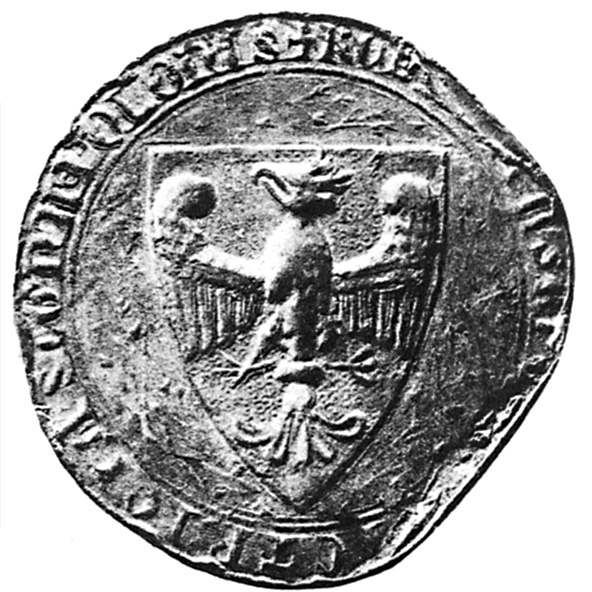 Majestatic Seal of Przemyslaw II |
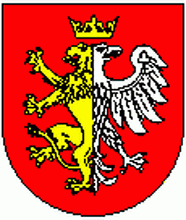 (1305-1320) |
Personal Arms of Prince Wladyslaw Lokietek
These Arms signify the principal possessions of Prince Wladyslaw Lokietek - Kuiavia and the Land of Sandomierz - half golden lion and half white eagle, on the red shield and under the golden princely crown.
Upon becoming the King, Wladyslaw Lokietek used the crowned white eagle symbol exclusively. |
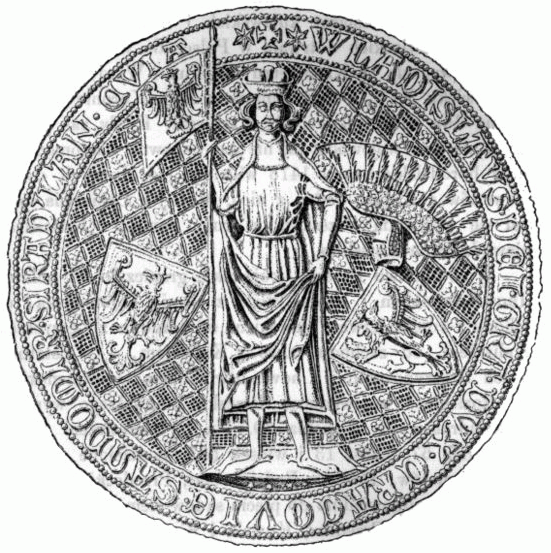 Wladyslaw Lokietek´s Wladyslaw Lokietek´s
Royal Seal
|
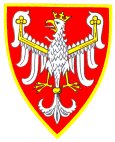 (1320-1333) |
Coat-of-Arms of King Wladyslaw I Lokietek
Wladyslaw the Short or Elbow-high (or Ladislaus I of Poland) (1261 – 2 March 1333), was a King of Poland. He was a Duke until 1300, and Prince of Kraków from 1305 until his coronation as King on 20 January 1320.
The coronation was a sign that he had overcome Poland´s internal fragmentation and re-united and re-instated the country as an independent kingdom under his rule. |
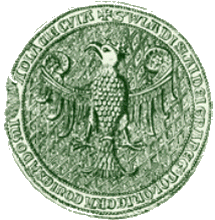 Wladyslaw Lokietek´s Wladyslaw Lokietek´s
Royal Seal
|
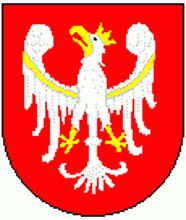 (1333-1370) |
Coat-of-Arms of Kazimierz Wielki
The White Eagle of Kazimierz Wielki (Casimir the Great) is a splendid example of the Gothic rendition of the bird. His White Eagle has an excellently outlined silhouette of an eagle, with head proudly thrown in the crown, with a sharp beak, wings spread wide, developed and strong tail, and powerful predatory talons. Thus, strengthening the role of the symbol of the emerging sense of national consciousness, the revival of patriotic feelings of all Poles.
The Polish White Eagle symbolized from the earliest times, the courage and heroism, the majesty and purity of aspirations of the peoples and states. |
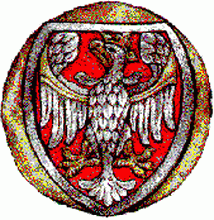 The Seal of Casimir the Great |
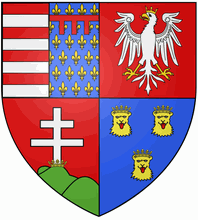 (1370-1382) 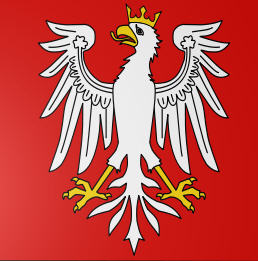 White Eagle (enlarged) |
Coat-of-Arms of Ludwik Wegierski
Ludwik Wegierski (Louis the Hungarian - Louis d’Anjou) was King of Hungary from 1342 and King of Poland from 1370 until his death. He was one of the most active and accomplished monarchs of the Late Middle Ages, and during his reign Hungary reached the peak of its political influence.
His White Eagle has a distinctive shape - very majestic. It is portrayed on the quartered royal Arms with the symbols of the House of Anjou (Andegavins), Hungary and Dalmatia. Louis was represented in Poland by his mother, Elisabeth of Poland, sister of Casimir the Great, and later, by his close friend, Duke Wladyslaw of Opole, as regents.
Louis was materially assisted by his lifelong alliance with his uncle, the childless King Casimir III of Poland, who had appointed him his successor. Louis waged successful wars against the pagan Lithuanians, Mongols, and against Bohemians. The young Louis had become very popular in Poland due to these campaigns. Not having sons, he made the deal with the Polish nobles to have one of his daughters chosen as the King of Poland. |
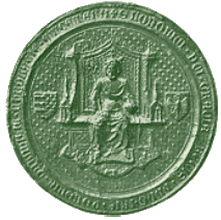 The Seal of Ludwik Wegierski 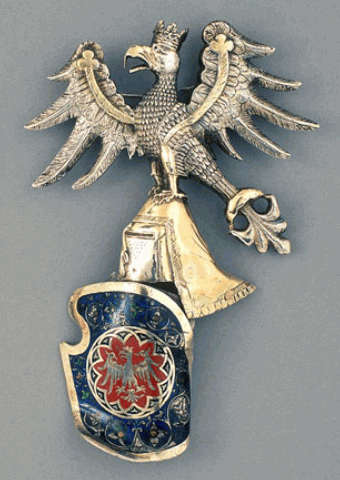 Angevin helmet and Polish Coat of Arms (1340s) |
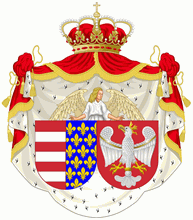 (1384-1399) |
Coat-of-Arms of Jadwiga (Hedwig)
Having been chosen the King of Poland, she agreed to marry the pagan Grand Duke of Lithuania, providing his conversion to Western Christianity., thus, laying the foundations for
the union of Poland and Lithuania, which, eventually became the most powerful state in the world in 16th and 17th Centuries.
Her royal Coat-of-Arms featured the White Eagle of Casimir the Great (her uncle) alongside the Arms of the House of Anjou (Andegavin). |
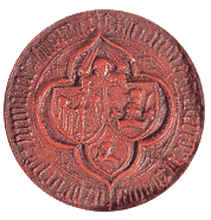 The Seal of Jadwiga |
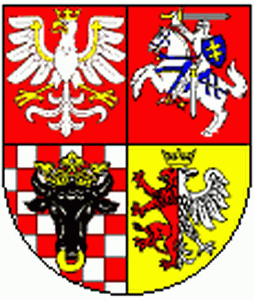 (1386-1434) 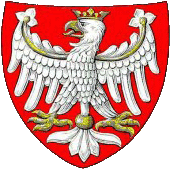 (1386-1434) |
Coat-of-Arms of King Wladyslaw II Jagiello
Jogaila, later Wladyslaw II Jagiello (born ca. 1362; died 1 June 1434), was Grand Duke of Lithuania and later King of Poland. He ruled in Lithuania from 1377, at first with his uncle, Kestutis. In 1386, he converted to Christianity, was baptized as Wladyslaw, married the young Queen Jadwiga of Poland, inducted into the Order of the Dragon and was crowned Polish king as Wladyslaw Jagiello.
His reign in Poland lasted a further forty-eight years and laid the foundation for the centuries-long Polish-Lithuanian union.
His personal Coat-of-Arms featured, besides the symbols of Poland and Lithuania, the ones of Greater Poland (Wielkopolska) and Kuiavia-Land of Sandomierz, given to him by the Parliament (Sejm) as his personal Polish domain.
|
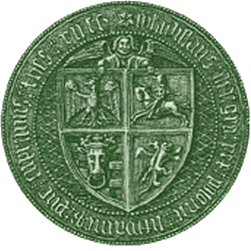 Royal Seal of Wladyslaw Jagiello 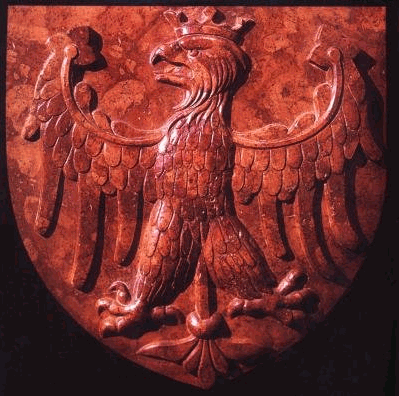 Wladyslaw Jagiello Wladyslaw Jagiello
Arms 1430
|
 (1506-1548) 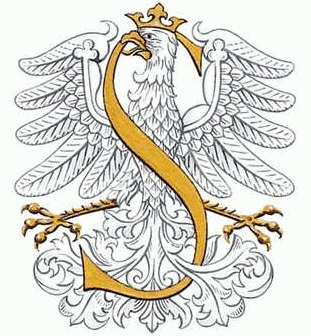 |
Coat-of-Arms of King Zygmunt Stary
Sigismund I the Old (Zygmunt I Stary) of the Jagiellon dynasty reigned as King of Poland and also as the Grand Duke of Lithuania from 1506 until 1548. Sigismund faced the challenge of consolidating internal power in order to face external threats to the country. During his reign he faced the results of the "Nihil novi" law which had been instituted by the previous king. It forbade the Kings of Poland from enacting laws without the consent of the Sejm.
Despite this, he established in 1527, a conscription army and the bureaucracy needed to finance it. He saw the end of the Polish wars against the Teutonic Knights in 1525, when Albert, Duke of Prussia and Sigismund's nephew, converted to Lutheranism, secularized the Teutonic Order, and paid homage to Sigismund as king. |
 Royal Seal of Sigismund the Old |
 (1492-1501) |
Coat-of-Arms of John I Olbracht
John I Olbracht (Albert), King of Poland (1492–1501), saw himself as the champion of Christendom against the Ottoman Turks. In 1496, he formed an army of 80,000 men in Poland to invade Turkey. Instead, his military build-up, along with rumors that he intended to put his younger brother Sigismund on the throne of Moldavia, resulted in a sudden war with Hungary. After several military failures in Moldavia, John was compelled to retreat. He blamed the szlachta (local nobles) for his defeat, and confiscated hundreds of their estates. The end of his unimpresive rule is remembered mostly for his struggles with the Teutonic Order, which ended with his sudden death in 1501. |
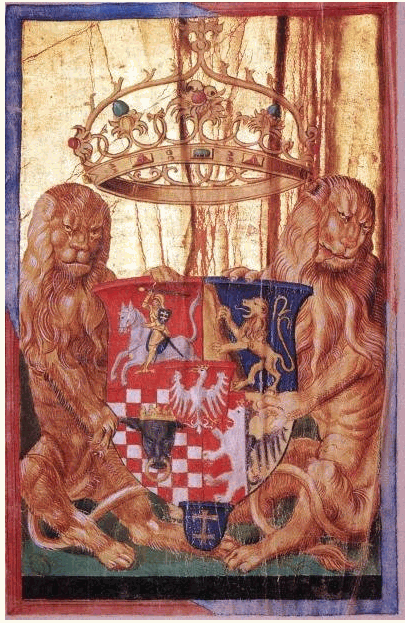 Tapestry of John I Olbracht |
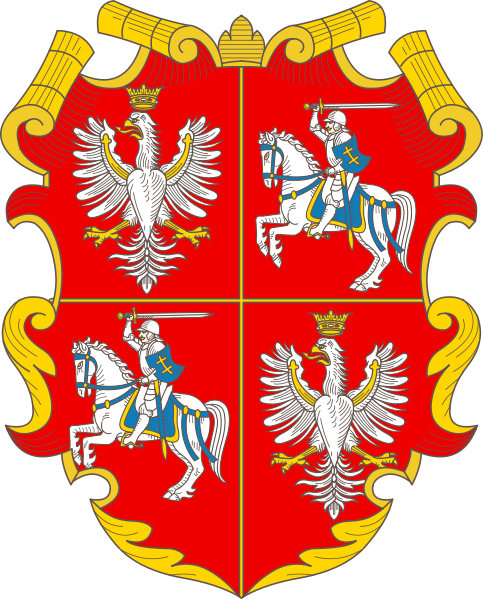 (1569-1795) |
Arms of the Polish-Lithuanian Commonwealth
The Polish–Lithuanian Commonwealth was formed by the union of the Kingdom of Poland and Grand Duchy of Lithuania in 1569. The new Commonwealth was one of the largest and most populous countries of 16th and 17th-century Europe.
The new union possessed features unique among its contemporary states: the Commonwealth´s political system (known alternately as the Noble´s democracy or Golden Freedom) was characterized by strict checks upon monarchical power. These checks were enacted by a legislature (Sejm) controlled by the nobility (szlachta). This idiosyncratic system was a precursor of modern concepts of democracy, constitutional monarchy and federation. The two component states of the Commonwealth were formally equal, yet Poland was the dominant partner of the union. |
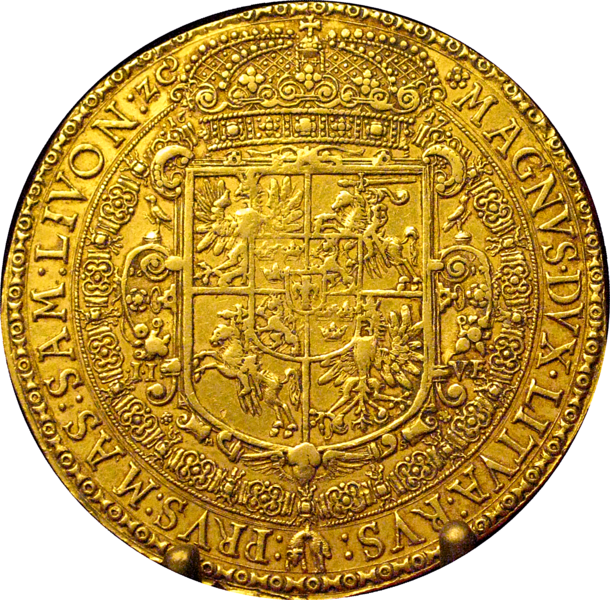 Coat-of-Arms of Polish–Lithuanian Commonwealth on 15 ducats piece Sigismund III 1617 |
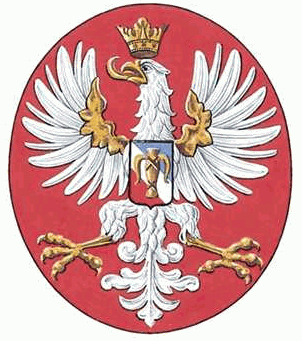 (1587-1668) Note the Vasas’ Arms as the heart shield on the chest of the Polish Eagle. |
Coat-of-Arms of Waza Kings
There were three of them, appearing as a dynasty, but all of them were elected separately, on their own merit.
Sigismund III Vasa (1587-1632) ruled Sweden and Poland until 1599, when he lost the Swedish throne because of his strong anti-Reformation stand. Under his rule the Polish-Lithuanian Commonwealth reached its apex, before going into a slow decline. Sigismund III is also remembered for moving the capital from Cracow to Warsaw. Under his banner, the Polish troops took Moscow and occupied Kremlin for two years.
Wladyslaw IV (elected Tsar of Russia in 1610) saw the development of Polish Navy, supported religious tolerance and carried out military reforms. He ruled Poland from 1632 to 1648.
John II Casimir (Jan II Kazimierz), was a Jesuit and Cardinal before being elected the King of Poland. His rule was marred by the new Polish-Russian War, the Swedish invasion (The Deluge), and Khmielnitsky Uprising in the Ukraine. Elected king in 1648, he abdicated in 1668 to become Jesuit again, in France.
|
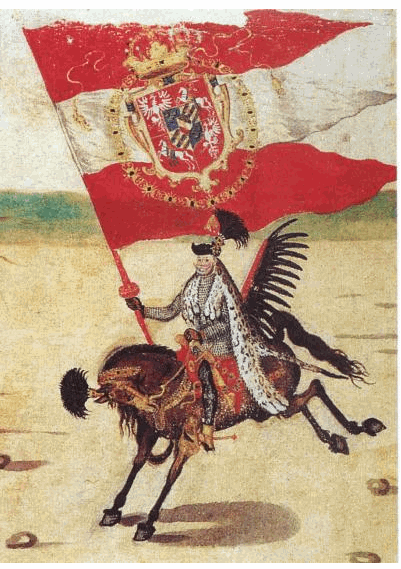 The Vasa Polish banner on the way to conquer Moscow. 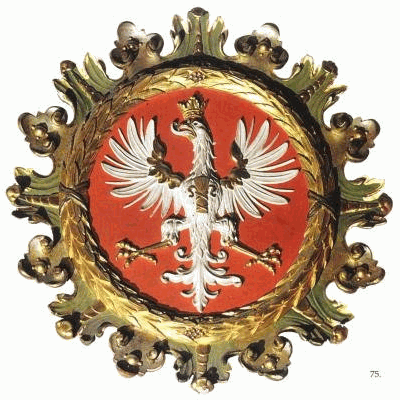 Royal Seal of the Waza Kings |
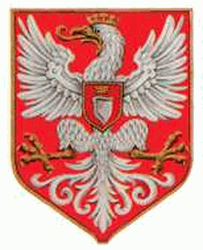 (1674-1696) |
Coat-of-Arms of John III Sobieski
John Sobieski was born 1629 in Olesko, a small town near Lviv in the modern day Ukraine, into the noble family of "de Sobieszyn Sobieski" of the Clan Janina. He became one of the best monarchs Poland ever had, considered a military genius, called the "Savior of Europe" (Vienna 1683), called by Turks, with great respect, the "Lion of Lechistan," an able administrator and negotiator, also, a romantic husband, tenderly loving his French wife, Marie Casimire Louise.
His emblematic White Eagle carried his personal coat-of-arms with a "Janina" as a heart shield on the eagle’s chest. Janina has several meanings today: it is a Polish nobility clan coat-of-arms, but it also means a "field in a field" or a "shield within a shield." |
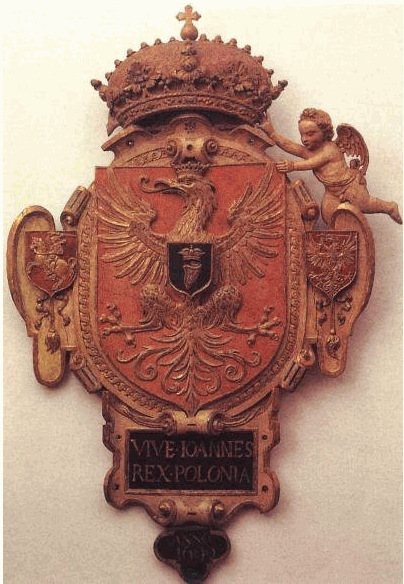 Royal Seal of John III Sobieski |
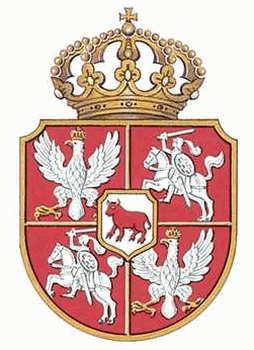 (1764-1795) |
Coat-of-Arms of King Stanislaw August Poniatowski
Stanislaw II August Poniatowski (1732–1798) was the last King and Grand Duke of the Polish-Lithuanian Commonwealth (1764–95). After the final, Third Partition of the Polish-Lithuanian Commonwealth, Stanislaw August was forced to abdicate (25 November 1795) and left for Saint Petersburg, Russia. There, a virtual prisoner, he subsisted on a pension granted to him by Empress Catherine the Great, and died deeply in debt.
King Stanislaw August remains a controversial figure. He was accused by some of striving for absolutism, of doing away with the liberties of the szlachta (Polish nobility), of desiring the downfall of the Roman Catholic Church; by others, of weakness and subservience, even of treason, especially after he had joined the Targowica Confederation. |
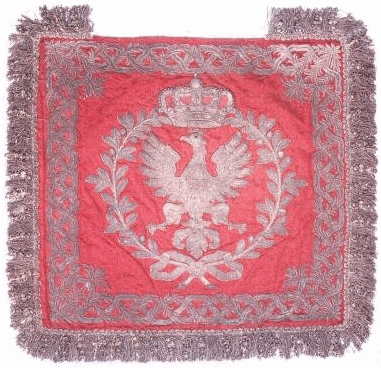 White Eagle on pillow case? |
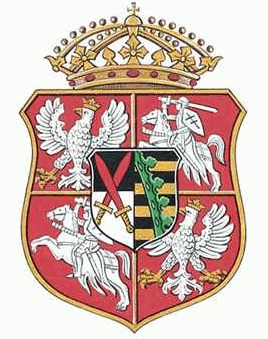 (1697-1763) 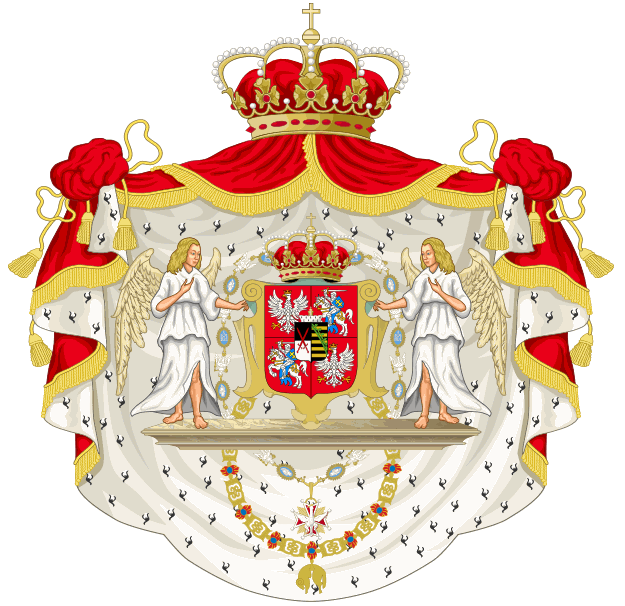 Wettin's Royal Coat of Arms |
Coat-of-Arms of the Wettin (Saxon) Kings
There were only two Saxon kings of Poland. The first was August II Mocny (August II the Strong), who was the king between 1697-1706 and 1709-1733. His rule was interrupted by that of Stanislaw Leszczynski (1704-1709 and 1733-1736).
The second Saxon king was August III Sas (Augustus III the Saxon) who ruled between 1734 and 1763. It was in the times of the conflicting interests of the bordering powers and the rapid decline of the Commonwealth. The rule of the Wettins only helped to bring the glorious Commonwealth to its knees.
Their Polish coat-of-arms included the Saxon Arms as the heart shield.
Nevertheless, because the Constitution of 1791 envisioned the return to the dynastic monarchy and stipulated the House of Wettin would assume the royal duties after the death of Stanislaw August Poniatowski, most of today's Polish monarchists recognize the head of the House of Wettin, Maria Emmanuel Wettin of Saxony, as the only legal pretender to the Polish throne. |
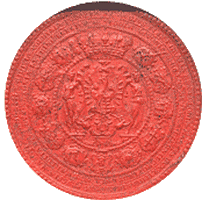 Royal Seal of August II Mocny 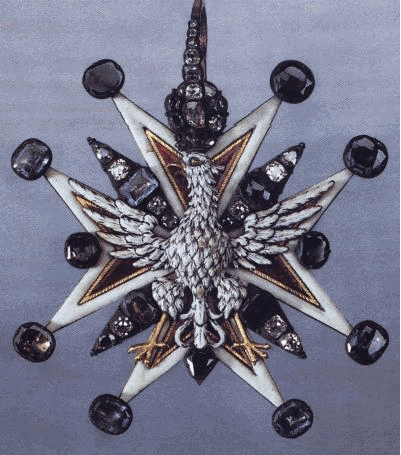 Order of the White Eagle established 1713 by August II the Strong |
| Polish Coat-of-Arms Part 1 (top of this page) | Continue on to Polish Coat-of-Arms Part 2 |
| Return to "Vexillological Essays and Chart Pages Menu" |
| Top of Page | Medieval Poland 900 to 1599 | 17th and 18th Century Poland 1600 to 1795 |
| Alliance of the Three Black Eagles (Poland Partitioned) 1795 to 1807 | Napoleonic Era and Poland 1807-1824 |
| The Congress of Vienna and its Aftermath 1820-1914 | World War I and the Parliamentary Democracy 1914 to 1926 |
| Second Republic of Poland (Sanacja) 1926 to 1939 | World War II (German and Soviet occupation) 1939 to 1945 |
| People's Polish Republic (Communist regime) 1945 to 1999 | Third Republic of Poland 1999 to present |
|